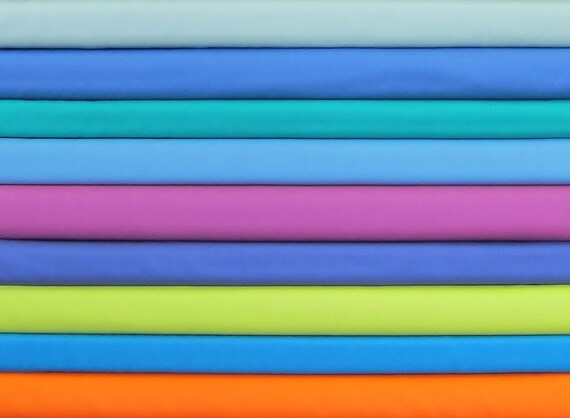 |
| detail, my Modern Flyng Geese, 2015 |
Flying geese blocks are simple, but somewhat tricky. In the diagram below, the white portion of the block is the goose, and the black is the sky. Contrast between the two is important for achieving the illusion of a bird in flight. A row of flying geese blocks is meant to represent the orderly migration of a flock of geese.
In late December I had purchased this wonderful collection of Pure Elements solids, pictured below, inspired by Frances Newcombe's Safari Moon print collection for Art Gallery Fabrics.
 |
| gorgeous Pure Elements solids: a starting point for my palette of geese |
After auditioning the fabrics, I decided not to use the chartreuse and orange. Instead, I swapped in some spring green, purple, and pale peach.
The bright colors would be my very energetic geese. They would travel boldly across cloudy skies, some puffy white snow-clouds, some lightly overcast, others stormy grey or darkest night. They would form orderly rows, but they would not all be going in the same direction.
I made all the geese first, then settled on a layout. As this was my first time making flying geese blocks, I used a helpful tutorial, linked here, by Karen Johnson from ConnectingThreads. You can see that I managed to preserve most of my points, but the height of my geese blocks was not uniform. I answered my momentary longing for order and perfection (I know, ridiculous on both counts) with a reminder that in nature, geese, like people, come in all sizes. Why should mine be any different? I can only tolerate so much order, anyway. Clouds, on the other hand, remind us of the imaginative possibilities of a glorious disorder. The answer? An extra patch of cloud chasing the geese, above left.
For the border, I used a geometric print by Sunbrella that reminded me of moons and snowballs and seemed a perfect whimsical pairing for my happy geese. For the backing I chose a field of mushrooms in a grayish taupe. I don't know if geese eat mushrooms, but if they do, they'll have plenty to snack on.
Rows of echo quilting accentuate the geese and create a whimsical zig zag effect on the quilt's back. I pieced the binding from a wild variety of bright printed fabrics that coordinate with the geese and frame the neutral border with a riot of color. Despite their appearance of order in flight, geese can be rambunctious. I like that. From a safe distance.
Update on Modern Flying Geese: I am delighted to report that this quilt has been purchased and the geese are flying to their new home in Australia. Safe travels!














